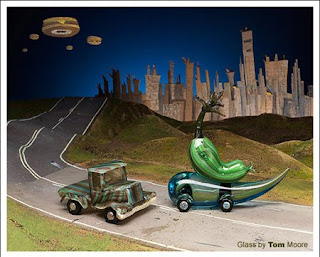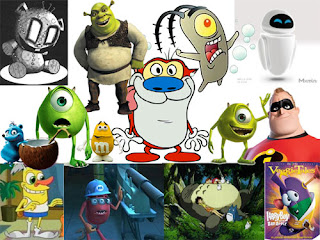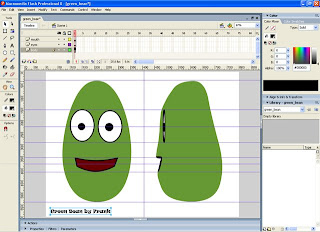Friday, February 27, 2009
Killer Bean Forever
Killer Bean Forever - Official Trailer - video powered by Metacafe
It's an 85 minute low budget CG film created primarily by one person. It looks entertaining. It must have been a mammoth task. And it proves further that animation is full of beans.
How to Make Links in Blog Comments
Making a web link in a blog comment from Frank G on Vimeo.
The code I typed in the video looks like:
[a href="http://www.website address"] link words [/a]
The sharp arrow brackets described look like: < >. Replace the square brackets [ ] in the code with the arrow brackets to make it work in a comment post.
Wednesday, February 25, 2009
Embed Video - From a Vimeo Account
Embed a Video from a Vimeo Account from Frank G on Vimeo.
Maya is "chugging"
Maya is 'chugging' from Frank G on Vimeo.
If you do this step to speed up Maya you may lose your sliders from your Blend Shape window. To fix that, if it happens, simply rebuild your Blend Shape as you were shown in the video tutorials using the Create Deformers menu in the Animation drop down menu set.
3D Modelling - 2nd Year Animators Class Photo
 Class photo of the Animators of 2009 - please email me label corrections and additions
Class photo of the Animators of 2009 - please email me label corrections and additions
Friday, February 20, 2009
Tell me if you know it's true
 Here is something I was thinking about as I was weaving through peak hour traffic on my scooter being chased home by a subtropical thunderstorm... If I were to say to you:
Here is something I was thinking about as I was weaving through peak hour traffic on my scooter being chased home by a subtropical thunderstorm... If I were to say to you:Learning is being interested in something and wanting to know more about it. It is the major task of a student.
In an attempt at a visual metaphor, learning is the gathering of shiny knowledge nuggets to put inside the treasure chest of memory inside one's brain.
The need to learn is the pilot light, the interest in the craft, flickering within the animation student.
Teaching is being interested in facilitating (helping) the learning by the animation student in a craft that the teacher is passionate about. It is about igniting the passion for animation within the student mind. The teacher is a big blast of flammable gas!
Maybe that didn't come quite right? Start again...
I have observed an interesting contradiction in some young animators. They want to be told the answers to important animation questions put to them in class. But at the same time they do not like to be told what to do. "Tell me the answers but don't tell me what to do." Hmm, fascinating. Quite the conundrum.
There seems to exist an impatience to be. To be an animator, maybe even a notion to be a good one, but not enough patience to apply the time to learn how. That is, to learn animation the best way by finding the answers for themselves.
Curiosity may have killed some cats, but to my knowledge it is not yet a lethal problem for animation students.
Let's face it, the animation teacher is not a repository of all animation knowledge. But animation teachers do know where to guide a student to look. And we do know the difference between an animation gold nugget and a polished turd.
Now before anyone goes jumping up and down trying to mount a high horse, 'polished turd' is a recognised animation industry term in common usage.
One of my animation teachers used to talk about, "The WHAT and the HOW" in animation and I hope he will one day write down his thoughts (he also talked a lot about polished turds). His context for "the WHAT and the HOW" was the what and how to animate.
I'm using it in the context of being. The what and how to be a good animator.
First up, the what. Ask an animation student, once they have enough information about the craft to actually want to continue practising it, rather than just be entertained by it, "What do you want to be?" They will invariably say, "A good animator."
Next, the how. "How do you get to be a good animator?" Voila! some fantastic facial animation video reference. Occasionally a blank look (that creates a mental uh-oh).
The how is about learning. Learning how to become a good animator.
There is a lot of fool's gold out there for the curious animation student who strikes out on their own without a map; things that look like animation information but are just a pile of polished turds. The teacher is the treasure map to show students where to find animation knowledge. "Y' dig?" Turds are just fine for making compost but, really folks, are no fun to dig around in.
The student is the treasure hunter. And there is a big mountain of animation gold (knowledge) in the world's libraries (even the one at SBIT), on the Internet, on DVDs, some in your teacher's memory, some in other animators and lots in the local industry full of experienced but time poor animators. The treasure map, the teacher, is trying to guide animators to it while avoiding the turds. Yup, I wrote turds again.
People don't get to be good animators without learning how to animate.
Ponder this, the treasure doesn't get delivered to Jack Sparrow's or Indiana Jones' front door. The murderer doesn't walk into Sherlock Holmes' office and give themselves up. These interested adventurers go out, do their research, dig around a bit here and there looking for clues and then they find it. The producers and financiers applaud as hard as the audience. Rhetoric warning. But did you ever notice the real treasure is all the things they discovered along the way?
The larger the desert to cross, the sweeter the beer on the other side. Next time you attempt to cross a desert you would have learned, taught yourself, that it is easier in the company of a camel and a bag of dates. And the beer in Agadir tastes like nectar. If you just jumped aboard the Polished Turd Airlines flight from Cairo, the beer in Agadir just tastes like Moroccan beer and all you've learnt is that they allow smoking in business class and that little curtain is no barrier to the stench. I think I just typed that because I'm thirsty.
The questions and tasks assigned in class are not "telling an animator what to do". They are a trail of information bread crumbs, carefully selected sign posts, to lead animation students along their own path of discovery in how to animate.
Facilitate your own learning. Bring the things that you find in your research, your discoveries while looking for the answers to tasks and assessment items. Bring them to your teacher and we will pick off the bits that look like turds and work out together whether it is animation fool's gold or the real thing.
Discovering the important things for yourself, while being guided by your teacher, will make you a good animator.
Tuesday, February 17, 2009
Character Design - Glass - GoMA
 Animators in Brisbane had a wonderful opportunity. An installation of work by Adelaide glass artist Tom Moore was up in the entrance foyer to GoMA (Gallery of Modern Art) as part of the 'Optimism' exhibition.
Animators in Brisbane had a wonderful opportunity. An installation of work by Adelaide glass artist Tom Moore was up in the entrance foyer to GoMA (Gallery of Modern Art) as part of the 'Optimism' exhibition. Tom Moore displays thought provoking, remarkable character designs based on hope and evolution, where nature and plants triumph over automobiles. All made in glass.
How often have you had people look at your character designs with initial bemused shock and then intense interest? Learn from this craftsman about where imagination can take your designs. Study more than animated film to inform your development as an animator. I'm pretty sure Miyazaki said something along those sentiments.
Thinking vs Planning & Doing
 Scrat knows all about "Doing!" - Ice Age 3 publicity image. Blue Sky Studios.
Scrat knows all about "Doing!" - Ice Age 3 publicity image. Blue Sky Studios.It is an important part of the process of learning animation. Doing is pronounced as "Do-ing", Do + Ing = Doing, as in, "What the heck are you doing!"
A wise employed animator once said, "The learning of animation is in the doing of animation."
Part of the process of animation is planning. When you are thumb nailing ideas, you are doing animation.
The animators who are planning their major project for this year need to know something important. This can be applied to any animation discussion between animation student and teacher.
When you approach your teacher to help plan your major project idea (or even a class exercise) bring with you a pencil and the notebook/sketchbook that you have specially bought for planning the task.
Take notes and draw thumbnails (plan) in the process of discussing your project.
These meetings are not "throw away" chats. They are PLANNING. We want to see results of your planning. Bring your planning out of your brain and put it on paper, please.
If you want to debate that point bring it to the table.
But make sure you bring a notebook and a pencil.
Sunday, February 15, 2009
Can of Beans - Character Shapes
 In preparation for a 3D character modelling assessment task these are some of the bean shaped characters found by the animators. Just goes to show that many major animation stars have been formed from the humble bean (shape). And if it is good enough for major studios to design and model bean shaped characters, it is an absolute must do for us.
In preparation for a 3D character modelling assessment task these are some of the bean shaped characters found by the animators. Just goes to show that many major animation stars have been formed from the humble bean (shape). And if it is good enough for major studios to design and model bean shaped characters, it is an absolute must do for us.
Saturday, February 14, 2009
Where's Linus?
 I just need to post this here as part of my teaching. The second year students will understand.
I just need to post this here as part of my teaching. The second year students will understand.
Friday, February 13, 2009
6B or not 6B... or maybe 2B? That is the question.
I have asked the first years to do their animation drawings with a 6B pencil. Thankfully a few more 2B pencils were held up today and even a few 6Bs and a 7B. Many still hold up illustrating tools (pacers) at the 'dailies' (meetings around the big table - simulating a studio meeting at the start of the day). When we work ruff, creating working drawings for animation it is better to use animation tools (a soft lead pencil).
The pacer will come into play (or out to play) when you have to produce cleaned up animation.
My animation teacher used to prowl the classroom getting the illustrators to put away their pacers when producing rough animation drawings.
I thought I would enlist a few important animators in this blog post to help me help the new animators see the benefit of a soft lead pencil in the animating phase of the animation process. These are people who know what they are talking about when it comes to animation.
Take special note how Glen Keane holds his pencil. There is more information about how to hold a pencil when drawing in animation and Glen Keane (I advise you to listen to the podcast and watch the clip at the link).
Thursday, February 12, 2009
How do I embed a video into my blog?
How to embed a video file in a blog from Frank G on Vimeo.
When selecting the Embed code click and hold down the left mouse button. To find the Embed code on a Vimeo video, put mouse over the screen and an "Embed" label button appears in the top right corner. Click on it.
Wednesday, February 11, 2009
Line of Action
An animation industry animator (click on the picture) described Line of Action principle to me as:
"The LOA thing is always a killer...
TWO THINGS
1) HOW THE CHARACTER IS FEELING.
2) WHAT THE CHARACTER IS DOING WITH ITS ENERGY
EVERY CHARACTER POSE MUST HAVE A LINE OF ACTION THAT SHOWS THESE TWO THINGS!"
Yes, he did use his "All Caps" voice because it is very important. The incident (pictured) was captured on a security camera (click here to see the footage).
To paraphrase Leonardo da vinci, "The ... attitudes of a figure should display the state-of-mind of him who makes them and in such a way that they cannot mean anything else."
Image used for educational purposes is from Toy Story © 1995, Walt Disney Pictures
Monday, February 9, 2009
Inspirational Animation
What is animation? Don Hertzfeldt explains... I advise just watching the section from 1:04 to 1:23 for the explanation. The other stuff, well, you have been warned.

